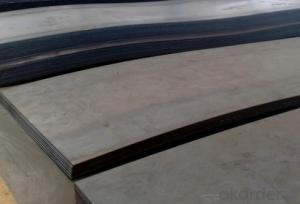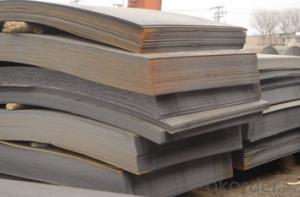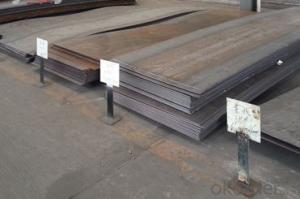Hot Rolled Carbon Steel Plate,Carbon Steel Sheet Q235C, CNBM
- Loading Port:
- Qingdao
- Payment Terms:
- TT OR LC
- Min Order Qty:
- 10 pc
- Supply Capability:
- 30 pc/month
OKorder Service Pledge
OKorder Financial Service
You Might Also Like
Quick Details
| Standard: | AISI, ASTM, GB, JIS | Grade: | Q195,Q235,Q345,A36,C45 | Thickness: | 1.0-30MM |
| Model Number: | Q235,Q195,Q345 | ||||
| Type: | Steel Plate | Technique: | Hot Rolled | Surface Treatment: | Coated |
| Application: | Ship Plate | Special Use: | Silicon Steel | Width: | 30-2000mm |
| Length: | as your requirement | standard: | hot rolled | Surface: | Anti-rust oil |
Packaging & Delivery
| Packaging Details: | seaworthy packages or as customers' require |
| Delivery Detail: | within 15 days after the advance payment |
Hot rolled steel plate
1 carbon steel plate 3mm thick General information
| Product name | Type | Specification | Implementation of GB | ||
| thick | wide | long | |||
| Carbon structural steel | Q195,Q215, Q235A,Q235B, Q235C,Q255, Q275 | 4-120 | 1500-4500 | 6000-12000 | GB/T700-2006 |
| Low-alloy structural steel | Q295,Q345A, Q345B,Q2345C | 4-120 | 1500-4500 | 6000-12000 | BG/T1591-1994 |
| Quality carbon structural stee | 30-50 | 4-120 | 1500-4500 | 6000-12000 | BG/T699-1999 |
| Ship steel | CCSA,CCSB | 4-120 | 1500-4500 | 6000-12000 | materials and welding condition |
| CCSAH32,CCSAH36 CCSDH32,CCSDH36 | 4-120 | 1500-4500 | 6000-12000 | materials and welding condition or GB 712-2000 | |
| Boiler steel | 20g,22Mng, 16Mng,19Mng | 4-120 | 1500-4500 | 6000-12000 | GB 713-1997 |
| Pressure vessel steel | 1622Mng,20R, 15MnVR,15MnVNR | 4-120 | 1500-2700 | 6000-12000 | GB 6654-1996 |
| European standard plate
| S235JR,S235J0, S275JR,S275J0, S275JR2,S355JR, S355J0,S355J2 | 4-120 | 1500-4500 | 6000-12000 | EN 10025 |
| Japanese standard plate | SS400,SS400-B | 4-120 | 1500-4500 | 6000-12000 | JIS G3101-2004 |
2 carbon steel plate 3mm thick detail specification
Material:
A283Gr.D/A573Gr.65,A516Gr65,A516Gr70,A284Gr.D
SS400,SS300,CCSB A36,A32,LRA32,LRB,Q235
Q195,Q235,Q345,SS400,ASTM A36,E235B
Thickness: 4mm-120mm
width: 1500mm-4500mm
Length:2-10m ,accordingly
Thickness | 4-120mm |
Width | 1500-4500mm or as custom's request |
Length | 2-12m,as your requirment |
Technique | Cold rolled or hot rolled |
Surface treatment | Bare, galvanized coated or as customer's requirements. |
Standard | ASTM,EN,GB,JIS,GB |
Material | A283Gr.D/A573Gr.65,A516Gr65,A516Gr70,A284Gr.D SS400,SS300,CCSB A36,A32,LRA32,LRB,Q235 Q195,Q235,Q345,SS400,ASTM A36,E235B |
Terms of Payment | L/C or T/T |
Chemical composition | C≤0.004%;Si≤0.030%; Mn ≤0.17%;P≤0.012%; S≤0.010%; Fe balance |
Delivery Detail | within 30days once receive deposite or confirm L/C |
Packing | Standard export packing,or as requirement |
3 carbon steel plate 3mm thick application:
construction,machinery manufacturing, container manufacturing, shipbuilding, bridge construction. Can also be used to manufacture a variety of containers, the furnace shell, furnace plate, bridge and vehicle static steel plate, low alloy steel plate,shipbuilding plate, boiler plate, pressure vessel plate, pattern plate, tractor parts, automobile frame steel plate and welding components
- Q:Can steel sheets be used for making staircases?
- Yes, steel sheets can be used for making staircases. Steel is a durable and strong material that can support heavy loads, making it suitable for constructing staircases. Steel sheets provide a stable foundation and structural integrity for staircases, ensuring safety and longevity. Additionally, steel can be easily shaped and molded into various designs, allowing for flexibility in staircase aesthetics. Whether it is a residential, commercial, or industrial setting, steel sheets are a popular choice for constructing staircases due to their strength, durability, and versatility.
- Q:What are the different sheet metal bending techniques for steel sheets?
- There are several sheet metal bending techniques for steel sheets, including air bending, bottoming, coining, and folding. Air bending involves applying force to the sheet metal to bend it using a V-shaped punch and a V-shaped die, without touching the bottom of the die. Bottoming involves bending the sheet metal until it comes into full contact with the bottom of the die, resulting in a tighter bend radius. Coining is a precision bending technique that uses a punch and a die to create a highly accurate and crisp bend. Folding, on the other hand, involves bending the sheet metal at a specific angle using a press brake or a folding machine. These techniques offer various options for achieving different bending requirements in steel sheet fabrication.
- Q:What is the difference between hot-rolled and cold-rolled steel sheets?
- The manufacturing process and resulting characteristics of steel sheets differ between hot-rolled and cold-rolled varieties. Hot-rolled steel sheets are produced by heating a large steel slab and passing it through high-temperature rollers. This allows for easy shaping and forming into various sizes and thicknesses. The elevated temperature also removes any residual stress in the steel, making it more flexible and moldable. Consequently, hot-rolled steel sheets possess a rougher surface finish and may exhibit a thin oxide layer called scale. However, they are generally less expensive and come in a wider range of sizes. In contrast, cold-rolled steel sheets are created by cooling down the hot-rolled steel and passing it through rollers at room temperature. This process not only reduces the steel's thickness but also enhances its surface finish and dimensional accuracy. Cold-rolling gives the steel sheets a smooth and shiny appearance, making them suitable for applications where aesthetics matter. Additionally, cold-rolling improves the steel's strength and hardness, making it more appropriate for high-stress uses. However, cold-rolled steel sheets are typically more costly due to the additional processing involved. In summary, hot-rolled steel sheets offer greater formability and lower cost, but have a rougher surface finish and may exhibit scale. On the other hand, cold-rolled steel sheets have superior surface finish, dimensional accuracy, and strength, but are pricier. Choosing between hot-rolled and cold-rolled steel sheets depends on the specific requirements of the application, including desired surface finish, strength, and cost considerations.
- Q:Are the steel sheets perforated or solid?
- The steel sheets are perforated.
- Q:What are the common applications of galvanized steel sheets?
- Galvanized steel sheets are commonly used in a variety of applications due to their excellent corrosion resistance properties. Some common applications include roofing and siding for buildings, automotive body parts, electrical appliances, ductwork, and agricultural equipment.
- Q:Can steel sheets be used for interior wall applications?
- Yes, steel sheets can be used for interior wall applications. Steel sheets provide durability, strength, and fire resistance, making them suitable for various interior wall applications such as in commercial buildings, industrial spaces, and residential homes. They can be installed as wall panels, partitions, or cladding, offering a modern and sleek aesthetic. Additionally, steel sheets can be easily customized, painted, or coated to match different interior design preferences.
- Q:What are steel sheets?
- Steel sheets are flat metal plates made of steel that are used in various industries for applications such as construction, manufacturing, and fabrication. They are typically thin and come in different sizes and thicknesses, making them versatile for a wide range of purposes.
- Q:How do steel sheets perform in fire-rated applications?
- Steel sheets perform exceptionally well in fire-rated applications. Due to their high melting point and excellent heat resistance, they offer superior protection against fire and help to contain its spread. Steel sheets are widely used in fire-rated walls, doors, and ceilings, as they maintain their structural integrity even at extremely high temperatures. Additionally, they contribute to fire safety by limiting the release of toxic gases and smoke, making them a reliable choice for fire protection in various industries and buildings.
- Q:Can steel sheets be used for agricultural applications?
- Yes, steel sheets can be used for agricultural applications. Steel is a versatile material that offers strength, durability, and resistance to corrosion, making it suitable for various agricultural purposes such as building structures, fencing, roofing, and equipment.
- Q:How do you prevent rust on steel sheets?
- One effective way to prevent rust on steel sheets is by applying a protective coating such as paint, zinc, or a corrosion-resistant primer. Additionally, keeping the steel sheets dry and avoiding exposure to moisture or corrosive substances can help prevent rust formation. Regular cleaning and maintenance, including removing any surface contaminants, can also contribute to the prevention of rust on steel sheets.
1. Manufacturer Overview |
|
|---|---|
| Location | |
| Year Established | |
| Annual Output Value | |
| Main Markets | |
| Company Certifications | |
2. Manufacturer Certificates |
|
|---|---|
| a) Certification Name | |
| Range | |
| Reference | |
| Validity Period | |
3. Manufacturer Capability |
|
|---|---|
| a)Trade Capacity | |
| Nearest Port | |
| Export Percentage | |
| No.of Employees in Trade Department | |
| Language Spoken: | |
| b)Factory Information | |
| Factory Size: | |
| No. of Production Lines | |
| Contract Manufacturing | |
| Product Price Range | |
Send your message to us
Hot Rolled Carbon Steel Plate,Carbon Steel Sheet Q235C, CNBM
- Loading Port:
- Qingdao
- Payment Terms:
- TT OR LC
- Min Order Qty:
- 10 pc
- Supply Capability:
- 30 pc/month
OKorder Service Pledge
OKorder Financial Service
Similar products
New products
Hot products
Related keywords






























